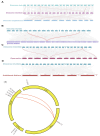Genome-Wide Identification, Plasma Membrane Localization, and Functional Validation of the SUT Gene Family in Yam (Dioscorea cayennensis subsp. rotundata)
- PMID: 40565219
- PMCID: PMC12193089
- DOI: 10.3390/ijms26125756
Genome-Wide Identification, Plasma Membrane Localization, and Functional Validation of the SUT Gene Family in Yam (Dioscorea cayennensis subsp. rotundata)
Abstract
Yam (Dioscorea cayennensis subsp. rotundata,hereafter referred to as Dioscorea rotundata) is a staple tropical tuber crop with notable nutritional and economic value. Its development and yield depend on efficient sucrose allocation from source tissues. Sucrose transporters (SUTs), a conserved family of membrane proteins, mediate sucrose loading, translocation, and unloading. Although well-studied in model plants and cereals, SUTs in yam remain largely uncharacterized. This study aims to identify and characterize the SUT gene family in yam and explore their roles in sucrose transport and tuber development. We conducted a genome-wide analysis of yam SUT genes, including gene structure, subcellular localization, and phylogeny. Molecular docking was used to predict sucrose-binding residues, and qRT-PCR assessed gene expression across tissues and tuber developmental stages. Eight SUT genes were identified and classified based on sequence similarity and domain structure. Docking analysis revealed key residues involved in sucrose binding and possible conformational shifts influencing transport. Expression profiling showed that most SUT genes, especially in the tuber apex, were progressively upregulated during development, suggesting roles in sucrose unloading and cell expansion. Additionally, functional validation of DrSUT1 in Arabidopsis thaliana confirmed its involvement in sucrose transport, supporting its role in yam sucrose partitioning. Yam SUT genes, especially those highly expressed in sink tissues, are involved in sucrose partitioning and tuber development. These findings provide structural and functional insights into SUT-mediated sugar transport and lay a foundation for improving sucrose utilization and yield in yam and other tuber crops.
Keywords: Dioscorea rotundata; gene expression; molecular docking simulations; sucrose transporter (SUT).
Conflict of interest statement
The authors declare that they have no known competing financial interests or personal relationships that could have appeared to influence the work reported in this paper.
Figures











Similar articles
-
Genome-Wide Identification and Expression Profiling of Plasma Membrane-Localized SWEET Gene Family Associated with Sugar Transport During Yam Tuber Development.Int J Mol Sci. 2025 Jun 18;26(12):5847. doi: 10.3390/ijms26125847. Int J Mol Sci. 2025. PMID: 40565307 Free PMC article.
-
Genome-Wide Characterization of DrRALF Genes in Yam (Dioscorea rotundata) Reveals Their Potential Roles in Tuber Expansion and the Gibberellin Response.Int J Mol Sci. 2025 Jun 26;26(13):6151. doi: 10.3390/ijms26136151. Int J Mol Sci. 2025. PMID: 40649928 Free PMC article.
-
Genome wide association studies in yam reveal the challenge of high heterozygosity.Sci Rep. 2025 Jul 24;15(1):26929. doi: 10.1038/s41598-025-10344-z. Sci Rep. 2025. PMID: 40707498 Free PMC article.
-
Nutritional labelling for healthier food or non-alcoholic drink purchasing and consumption.Cochrane Database Syst Rev. 2018 Feb 27;2(2):CD009315. doi: 10.1002/14651858.CD009315.pub2. Cochrane Database Syst Rev. 2018. PMID: 29482264 Free PMC article.
-
Cost-effectiveness of using prognostic information to select women with breast cancer for adjuvant systemic therapy.Health Technol Assess. 2006 Sep;10(34):iii-iv, ix-xi, 1-204. doi: 10.3310/hta10340. Health Technol Assess. 2006. PMID: 16959170
References
-
- Wang Z., Wei X., Yang J., Li H., Ma B., Zhang K., Zhang Y., Cheng L., Ma F., Li M. Heterologous expression of the apple hexose transporter MdHT2.2 altered sugar concentration with increasing cell wall invertase activity in tomato fruit. Plant Biotechnol. J. 2020;18:540–552. doi: 10.1111/pbi.13222. - DOI - PMC - PubMed
MeSH terms
Substances
Grants and funding
LinkOut - more resources
Full Text Sources
Miscellaneous

